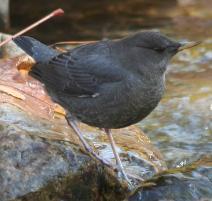Dipper 
Dippers or (Water Ouzels) are usually seen along fast
moving creeks or rivers.
Identification and Pictures
American Dippers (Cinclus mexicanus)
are song birds that swim. They are shaped somewhat like a large wren with a stubby
tail. They have a slate-gray body, dark eyes, and beak, long
gray legs, and may
have a brownish head. The eyes appear to flash white
when it blinks because of white feathers on the eye lids. These birds are around 7 to 8 1/2
inches. Males and females look alike. Young birds
look like the adults, but may have white tips on their
feathers. They get their name from their constant
dipping motion as they bend, and straighten their knees.
Photos by Keith
Lee. The camera I use is the Canon
EOS 40D. Visit All-birds store
Dippers have down below dense waterproof feathers.
They waterproof the feathers using oil from a large preen gland. Their blood can
store more oxygen than most passerine birds. These adaptations
plus a flap which covers the nostrils, and a clear membrane called a "nictitating membrane"
which can cover the eye allow dippers to
dive, and search for food under water. They also have
strong toes which allow them to grasp rocks on a stream
bottom. Their average dive is 5 seconds, but they can
stay down longer.

Dipper sound
Dipper (zeet) call: Click for Sound
Dipper song Click for
Sound
Both male and female sing all year with loud, repeated whistles. They
often give a high zeet sound. During flight they give a
rattling call.
Preferred Habitat
Dippers will inhabit stream, and river beds in the mountainous regions of western North America,
where they can be seen diving, and swimming under water for
aquatic insects, and small fish. You may see a dipper
dive from a bolder, and bob back to the surface a few seconds
later with an insect. Unfortunately their habit of
swimming sometimes makes them prey for large fish.
Unless their stream ices over they will remain in an area all
year.
Breeding and Nesting
A pair of dippers will defend a territory
along a stream bed from March through July. They will
approach intruders in a high posture with their bills pointed
into the air, and may chase them. This often ends when
one bird submits, and the victor pecks it or even forces it
under water. During courtship the birds will strut, and
sing in front of each other with their bills pointed up, and
their wings drooping. American dippers build a bulky nest of moss,
grass, and leaves, with an opening on the side. The nest will be close to
water, possibly on the bank of a stream or river, on a rock ledge,
or under a bridge. The female will choose the nest site,
and both birds will build the nest together. They will
often reuse or build over an old nest. The
female will lay 3 to 6 white eggs which she will incubate for
around 13 to 17 days. Both adult birds will feed the
young, which will fledge in around 20 to 25 days, and can swim,
and dive as soon as they leave the nest. the side. The nest will be close to
water, possibly on the bank of a stream or river, on a rock ledge,
or under a bridge. The female will choose the nest site,
and both birds will build the nest together. They will
often reuse or build over an old nest. The
female will lay 3 to 6 white eggs which she will incubate for
around 13 to 17 days. Both adult birds will feed the
young, which will fledge in around 20 to 25 days, and can swim,
and dive as soon as they leave the nest.
After nesting they will molt, but unlike most
song birds dippers loose all their feathers at once so they
are unable to fly for a short time. When molting is done
dippers may move downstream to avoid the ice buildup as winter
comes.
Food
Dippers feed by wading, diving, and swimming in water
for aquatic insects, small fish, and fish eggs. They also
catch flying insects out of the air.
To
learn about other favorite birds click here.

|
